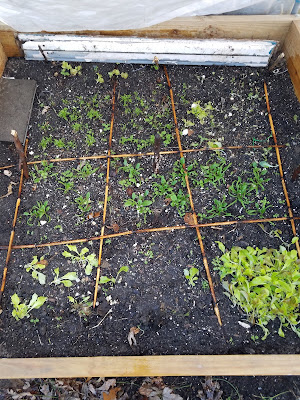As can be seen, the lettuces are not faring too well at this point. I think it is due to a combination of picking the wrong variety of lettuces and the lack of a strong enough sun getting through the layers. The other crops, however such as the spinach, carrots and onions seem to be faring quite well at this time. So, overall, I'd say it is definitely a mix bag of results. The true test will be when our winter weather is upon us and how frozen the ground in the structure actually gets.
I went out today and made a path to this part of the garden as it was getting quite muddy given the rains we have had. I raked the ground and laid foot stones to the plants as can be seen below.
As you can see, it will reduce the mud situation for me until it snows. I'll cross that bridge when the soon approaching time comes. My plan is to plant the area with grass this Spring so I don't have to deal with weeds next year. You can also see that the winter rye is doing fairly well in the beds given it's late planting and the temperatures. It will at least have laid down roots for the next summer crops which will add structure and nutrients.
I am also continuing to add plant material and kitchen scraps to my compost bin. This isn't the usual time of the year to be doing this but our temps have been somewhat moderate. The weather is supposed to be very mild through this week with a high of 60 tomorrow and mid-high 40's the rest of the week. While the process of the breakdown has slowed at this point, I had a bunch of scraps yesterday from our Christmas family dinner so I decided since it was almost 50 yesterday and was going to remain that way for a few days, why not add them to the existing pile? You can see that in the photo below.
The egg carton is biodegradable and so are the paper towels. The egg shells will break down with a little effort on my part in the spring and the potato peels will disappear eventually. After I added the various items, I covered them with a heavier layer of decomposing grass cuttings I saved just for this use.
I will add some leaves in the early spring along with kitchen scraps to get the decay process reignited for the next season. But for now, I have to keep an eye on the temps to insure that the edible scraps actually break down. I don't want to invite any uninvited guest to my yard.
Below is a picture of the units that I use to compost given our areas population of field mice. They have worked out really well for my area,
I also began prepping for my first plants to start from seed. According to my calculations, Broccoli and Cabbage need to be started around the 22nd of January and Cauliflower follows on the 29th . I also plan on growing peas this year. As I said early in this post, I plan on making this garden the best ever and that entails a wider array of plants - and a lot of planning. So, I won't be having a bumper crop of tomatoes or peppers like I did in 2016.
That's a wrap for all that is going on in the garden at this time. Seems like it's a lot but it has been somewhat therapeutic to say the least. This is probably my last post for 2016 so I will wish you and yours a very Happy and Safe New Years. Until next time, Happy Gardening everyone!













































